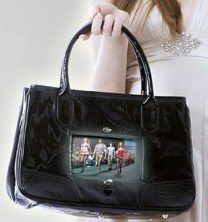(Nice article from http://www.businesspundit.com)
This country is full of idiots, socialists, and rednecks. At least that’s what partisans will have you believe.
As long as you’re railing against the people you hate, you can’t see the reality behind the rhetoric. These problems go beyond Liberal or Conservative, Republican or Democrat. They’re serious enough to contribute to internal collapse. We dug up 7 systemic problems that have nothing to do with political parties, yet are still killing America.
Note: Kevin at National Strike Day, which happens May 10, 2010, contributed to this article.
Collapsing infrastructure

Image:
Sanbeiji/Flickr
Recently, a drinking water supply line burst in Boston. Affected people
had to boil water before drinking it.
Boiling drinking water sounds shocking today. But unless we update the country’s infrastructure, boiling water (and collapsed bridges and burst dams) will become weekly news.
The American Society of Civil Engineers’
2009 report card tallies the hazard:
1,819 of the country’s dams are deficient “high hazard” dams (dams that will destroy buildings and kill people if they burst).
7 billion gallons of clean drinking water are lost per day through leaking pipes.
1 in 4 of the country’s bridges are either structurally deficient or functionally obsolete.
1/3 of the country’s roads are in poor or mediocre condition.
Combine that with natural disasters, like floods and earthquakes, and you have a nation constantly firefighting fallout from bad infrastructure. Infrastructure updates would prevent Katrina-sized outcomes. They’d keep our economy flowing, keep our water supply safe, and keep us looking like a developed country.
Loss of economic independence
 Image: DaveFayram/Flickr
Image: DaveFayram/Flickr
Right now, the rest of the world owns $3 trillion more of us than we own of them. -Warren Buffett in 2006
In 1979, manufacturing comprised 21% of the economy. In 2008, that number was 11.5%. One in six factory jobs
disappeared between 2000-2007. When a factory goes away, it takes its supply chain, R&D, and other supporting companies with it. Richard McCormack
writes that “one manufacturing job supports 15 other jobs. No other category of job has such a high multiplier.”
By outsourcing much of our manufacturing, we ended up relying on services to support the economy. It’s a precarious situation, especially since services are outsourceable, too. One
Princeton economist says 40 million jobs could be shipped out in the next 10-20 years, including 1 out of 3 service jobs.
What have gained by transferring our manufacturing (and, by association, knowledge and wealth) to other countries? A
massive trade deficit with
90 countries, for one. Consumers and companies don’t have a choice of where to buy products. They’re made abroad by default. If they were made here, they’d be prohibitively expensive, thanks to stringent regulatory requirements that the US doesn’t apply to goods produced elsewhere. It’s no wonder we’re a country that consumes more than it produces.
We have a trade imbalance of
$232.5 billion with China alone. China produces most of the goods that American consumers buy. American companies offshore there because China is cheap and doesn’t have expensive regulations. Moreover, China owns an
estimated $1 trillion in US Treasuries. Yet the US only makes up about
12% of China’s trading. If China drops the ball, we flounder. We’re forced to politically tap dance with China in order to maintain economic stability.
All of this makes us look more like a colony than a sovereign country.
The lobbyist industry

Ever get the feeling the government just isn’t listening to you? All you need to do to get a response is slip a couple million dollars into your Congressman’s pocket. Up the money tenfold, and you’ll probably get your own law. This is the power of lobbying in the US.
Politicians listen to you when they want your votes. Once they’re in office, the currency changes to cash. During the first 3 months of 2010 alone, lobbyists
spent almost $1 billion to influence the government.
The four primary lobbying groups—health interests, business associations, energy companies and Wall Street firms—each spent more than $123 million lobbying during Q1 2010, according to
Open Secrets. That’s
$1.37 million per day. Last year, lobbyists spent almost $3.5 billion total, that we know of.
If lobbyists are lucky, they’ll get regulators drooling on their laps. The pharmaceutical industry, for example,
legally pays the FDA to speed up the drug approval process. The FDA, which monitors labeling and drug safety, is basically paid to do what its main funder, the pharma industry, tells it to. No wonder consumers don’t usually find out about adverse drug effects until years later.
Few laws exist to put distance between politicians and lobbyists. Bribery is both systemized and legal. Meanwhile, lobbying reform has been minimal. Lobbying makes our claims to democracy look more like reality TV than truth.
Obesity
 Image: Tobyotter/Flickr
Image: Tobyotter/Flickr
Two-thirds of Americans are overweight or obese.
33% of children are obese. Nearly 50% of African-American and Hispanic women are
overweight or obese. If you’re
a suburbanite or
sit in front of a computer for hours a day, you’re also at risk.
What gives? If you trace obesity back to its roots, you’ll come back to the waterbed that government and industry cavort on every night. The government pays $20 billion per year to subsidize agriculture. Feed grain, corn, and wheat are some of the biggest recipients. As a result of subsidies and scale, food made with refined grains, sugars, and beef is cheap. Consumers, short on time and money, can buy a “complete” meal for cheap.
If you’re a poor American, you’re
more likely to buy cheap, bad-for-you food and grow obese. If you’re obese, you’re more likely to develop diabetes, cancer, and the host of other diseases that cost the US an estimated $100 billion per year.
If you can afford health insurance to treat those problems, great–the US insurance industry, including health insurance,
owns $2 billion in stock in the country’s five biggest fast food companies. And if you feel insecure about your weight, there’s a
$35 billion/year weight loss industry waiting to sell you temporary self-esteem.
The bottom line: Government subsidies help make fast food cheaper than healthy food. Poor people, women, and children are most likely to become obese. Lacking the resources, motivation, or know-how to stop eating the stuff that makes them obese, people turn to a gargantuan dieting industry for a quick fix. Insurance companies also don’t mind if you turn to their products when your weight makes you sick.
Maybe obesity is an epidemic, but some very important people aren’t arguing with it.
The revolving door
or
 Image: Dan4th/Flickr
Image: Dan4th/Flickr
After their terms end, many politicians become lobbyists for the same corporations and industries they used to regulate. 43% of Congressman and Senators who left the government between 1998-2005 became lobbyists, according to
one study.
These former politicians retain access to all of the Congressional and House amenities they had during their days on Capitol Hill. They can legally join their politician buddies in the House gym or Senate floor. Their companies are allowed to buy politicians fancy meals, gifts, and trips.
Many politicians later rotate back into government in a different role. Larry Summers, for example, is today’s Director of the National Economic Council. Before that, he was the managing director of D.E. Shaw & Co., a massive Wall Street hedge fund. Before that, he was Secretary of the Treasury. You see how this works.
National laws support the revolving door. Former policymakers can jump into corporate boardrooms and corporate executive leadership teams with no wait. After one year, they can
contract for the military.
What if these laws were extended to five years, without loopholes? The poli-lobbyist club would be broken up, or at least seriously dented. Lobbying would lose some of its exclusivity and, as a result, some of its power. The words
conflict of interest would once again enter our legal vocabulary.
Using personal funds for campaign purposes
 Image: Saad Akhtar/Flickr
Image: Saad Akhtar/Flickr
Back in the day, we elected a tailor (Andrew Johnson), a teacher (James Garfield), and several farmers to office.
Can you imagine that happening today? 44% of
Congressman are millionaires. Senators had a median reportable net worth of $1.79 million in 2008. Mike Bloomberg alone spent more than $100 million dollars of his own money in the New York City mayoral race. Linda McMahon has stated she is prepared to spend $50 million of her own money in the Connecticut Senate race.
If you have to be personally wealthy to run for office, “poor” (read: non-millionaire) candidates hardly stand a chance. The result is a ruling class of rich, out-of-touch politicians.
No term limits
s

In the United States, presidents can only stick around for 8 years. But our other two branches of government, the legislative and judicial branches, can be around forever.
US Senators have an unlimited number of six-year terms. Congressmen can be elected to 2-year terms as long as they run. Supreme Court justices stay for life.
This system practically lays out the red carpet for oligarchy. Companies
bribe build long-term lobbying relationships with politicians. In return, those politicians devise laws and exceptions benefiting those companies. Supreme Court justices do the same, often ruling
in favor of corporations.
Our infinite terms have produced visionless, complacent back-scratchers instead of leaders. Why we don’t choose to limit House, Congress, and Supreme Court terms in a democracy is beyond comprehension.
If you’re inspired to take action, check out National Strike Day 2010, a nonpartisan citizen effort that happens on May 10, 2010.




 If you’re tired of carrying around a plain water bottle, Original Wraps, Inc. and Nalgene have combined forces to allow you to create a customized, full-color, photo-quality vinyl wrap for a Nalgene water bottle. If you already have a Nalgene bottle, you can buy just a wrap for $8.95 (16 oz bottle) or $9.95 (32 oz bottle). You can get a wrap and a bottle for $14.95 (16 oz bottle) or $19.95 (32 oz bottle). (If you opt to buy a bottle and skin, it seems that a gray bottle is your only choice.) You upload your own image to NalgeneSkins and use their design tool to further customize it by drawing or adding text. You should expect to receive your skin or bottle and skin in less than two … [visit site to read more]
If you’re tired of carrying around a plain water bottle, Original Wraps, Inc. and Nalgene have combined forces to allow you to create a customized, full-color, photo-quality vinyl wrap for a Nalgene water bottle. If you already have a Nalgene bottle, you can buy just a wrap for $8.95 (16 oz bottle) or $9.95 (32 oz bottle). You can get a wrap and a bottle for $14.95 (16 oz bottle) or $19.95 (32 oz bottle). (If you opt to buy a bottle and skin, it seems that a gray bottle is your only choice.) You upload your own image to NalgeneSkins and use their design tool to further customize it by drawing or adding text. You should expect to receive your skin or bottle and skin in less than two … [visit site to read more]



 Zynga, the company behind FarmVille, is bringing its virtual world into your local real-world 7-Eleven. Buying a real object, like a FarmVille-branded Big Gulp, gets you a code that can be redeemed for an in-game object in Zynga's games. The promotion starts June 1st, but I spotted some FarmVille Vanilla ice cream at my neighborhood 7-11 last week.
Zynga, the company behind FarmVille, is bringing its virtual world into your local real-world 7-Eleven. Buying a real object, like a FarmVille-branded Big Gulp, gets you a code that can be redeemed for an in-game object in Zynga's games. The promotion starts June 1st, but I spotted some FarmVille Vanilla ice cream at my neighborhood 7-11 last week.












